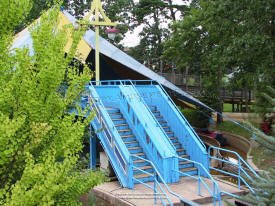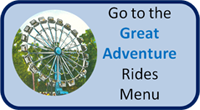
The Hydro Flume was the second flume built in the
park. With the immense popularity (and long lines) of the Log Flume in
the inaugural season, the park quickly decided to add this second flume
for the 1975 season.
The first public mention of adding a second flume came with the
publication of the Souvenir Book in the summer of 1974, when on the back
page in the "Tomorrow" section, which described the park's future it
mentions plans to add "A second, more spectacular flume".
While the Hydro Flume promised to be the park's premier water ride, it
never quite lived up to expectations. Its secluded location during the
early years, and later its shortened operating season meant it never
drew nearly the same size crowds as the Log Flume, or later Roaring
Rapids and Splashwater Falls.
After years of neglect, the ride was given major rehabs in the 2005 and
2006 seasons, and was finally removed in the 2006-2007 off season as
part of the installation of Wiggles World.
|
| |
|
|
 |
| |
|
|
 |
 |
 |
| |
|
|
| |
PLEASE NOTE:
Onride photos posted here were taken
before the park had placed
restrictions on onride photography.
Please adhere to current park rules.
Construction began on the Hydro Flume during the 1974-75 off season, and
the ride made its debut in summer of 1975.
The ride differed from its sister log flume in that it was slightly
taller, offering a longer, more thrilling drop.
Also, the Hydro Flume design utilized all the water pumped into the
flume trough in the final drop, where the Log Flume design had the water
bypass the drop, with a smaller pump supplying water that basically
provided the appearance of the logs floating down hill, while they
actually run completely on rollers. The Hydro Flume design dispersed
the water by spreading it out between two channels, allowing the boats
to roll down the drop safely on a thin sheet of water. the double
channel drop also helped increase ride capacity, allowing the operation
of more boats spaced closer together.
At the base of the drop, the boats also hit a speed hump, giving them
an extra pop of air time and creating larger splashes as they slowed in
the amassed water in the lower basin.
Like the Log Flume, the loading station was designed using a turntable
which kept the boats moving while allowing safe boarding and
disembarking. Other parks chose to install flumes that required the
log to stop for loading and unloading, while passengers had to contend
with a vehicle that bobbed up and down on the moving current, creating
safety concerns. The turntable allowed guests much more time for
boarding and disembarking, and allowed ride operators more time to group
riders and ensure higher capacity.
The ride queue was originally configured as two mirror image lines,
which only came together at the base of the stairs. Later this
configuration was replaced with new railings to form a single queue
line. The divided entrance stairs were setup to help fill boats, with
groups of one or two on one side and groups of three or more on the
other, allowing the ride operators to easily and quickly fill empty
seats.
|
|

Photos of the Hydro Flume
from the 1976 press kit
 |
 |
 |
 |
| |
|
 |
 |
| |
|
 |
 |
| |
|
 |
 |
| |
|
 |
 |
| |
|
|
 |
 |
 |
| |
|
|
 |
The shape of the fronts of the flume boats helped create a larger splash
down as they bounced along the lower trough, ensuring a wetter ride
which was much appreciated on hot summer days!
In the years up until 1991, the Hydro Flume had a secluded location,
surrounded by the native forest which was carefully preserved around it
during construction. The only attraction sharing the area until that
point was the Great Train Ride, which meandered through the woods, under
the flume course until its removal after the 1980 season. |
 |
| |
|
 |
 |
| |
|
|
 |
 |
 |
| |
|
|
 |
As part of an effort
to make rides safer in the spring of 1988, the Hydro Flume received
modifications which altered the ride's final drop for the rest of its
existence.
The speed hump at the base of the drop was removed, taking away one of
the most memorable and exiting parts of the ride.
Also modified was the drop itself, with the outer channel being
permanently closed off to boats. This helped alleviate the problem of
boats jamming at the top when they would occasionally get caught in the
gates that sent them down the two sides alternately. Instead, a single
gate was retrofit to the top, allowing the boats to be safely
separated.
The ride's popularity was already waning at this point, since Roaring
Rapids and Splashwater Falls both offered not just ways to get wet, but
get absolutely soaked. The diminished thrill of the ride combined with
its location in a remote corner caused many guests to simply overlook
it, until things changed drastically at the end of the 1990 season when
construction began on the park's Adventure Rivers section, where the
Hydro Flume would become the centerpiece. |
 |
| |
|
 |
 |
| |
|
 |
 |
| |
|
 |
 |
| |
|
|
 |
 |
 |
|
|
|
Hydro Flume 1991-1998
The Adventure Rivers Years: Irrawaddy Riptide |
| |
|
|
 |
 |
 |
| |
|
 |
 |
| |
|
|
 |
For the 1991 season, Hydro Flume received a cosmetic makeover and one of
its half dozen name changes as it transitioned to become the Irrawaddy
Riptide, named for a river in Asia.
The station structure received a new bright read canvas roof and the
entry stairs and boats received fresh, bright paint as well, giving the
ride an Asian theme, and a new lease on life.
In addition, a stairway was added allowing guest to pass over the
concrete trough as it meandered from the station to the lift hill.
|
 |
|
 |
| |
|
|
 |
 |
 |
| |
|
 |
 |
| |
|
|
 |
 |
 |
| |
|
|
 |
The Adventure Rivers
makeover opened up new views, both of the ride and from the ride, as new
paths and new slide towers were added alongside, and inside the course
of the flume. The Asian Tower was nestled into the coils of flume, and
rose above the upper sections of the ride.
In its time as part of Adventure Rivers, the Hydro Flume experienced
renewed popularity and increased ridership.
Many riders took the flume for its panoramic views of the surrounding
attractions. Passing especially close to the Asian Tower offered a new
thrill for both flume and slide riders.
The Asian Slides required the placement of footers in the Hydro Flume
reservoir, which were left in place long after the slides had been
removed. |
 |
| |
|
 |
 |
| |
 |
| |
|
|
 |
 |
 |
| |
|
 |
 |
| |
|
|
Hydro Flume 1999-2006
After Adventure Rivers |
| |
|
|
 |
In 1999, the
Adventure Rivers slide complexes were removed, and the area around the
flume was cleared to make way for a new section, Looney Tunes Sea
Port.
As part of the remake of the area, sections of the concrete trough were
re-aligned. The top three pictures on the right show the construction
process as first a concrete pad was laid, with rebar inserted to
strengthen the walls. Wooden forms were placed, and the concrete walls
were poured to match the existing trough sections.
In addition, a second bridge was constructed to create a connection
between the two halves of Looney Tunes Seaport. This long wooden
bridge offered more stroller and wheelchair friendly access than the
previously constructed steps which were also left in place. |
 |
| |
|
 |
 |
| |
|
 |
 |
| |
|
|
 |
 |
 |
| |
|
 |
 |
| |
|
|
 |
For a while, the
upper sections of flume were strung with rope lights.
Almost as often as the ride changed names, it also changed neighbors,
with rides like Batman The Ride, Skull Mountain and Nitro being added to
the surrounding area. Despite new additions around it, the Hydro Flume
continued to be treated as a second class ride, with shorter and shorter
operating seasons, and increasing neglect of cosmetic maintenance each
year.
For a time, Six Flags corporation struck a deal with the Dannon Water
Group, which resulted in parks nationwide renaming flume rides and other
water attractions with the names of the local Dannon Brands water. The
Hydro Flume received the name Poland Springs Plunge, as did one of the
slides in Hurricane Harbor.
After the ride sponsorship was dropped, the ride reverted back to the
Riptide name, and its sign was brought back out of mothballs.
To try and generate additional revenues as well as offering another way
to ensure riders got wet, coin operated sprayers were added to some of
the park's water rides, including Hydro Flume, which featured a bank of
them at the end of the drop. Spraying unsuspecting riders became a
spectator sport on the bridge on those days when the flume was running.
|
 |
| |
|
 |
 |
| |
|
 |
 |
| |
 |
| |
|
|
 |
 |
 |
| |
|
|
 |
Age and neglect really began to take their toll on
the Hydro flume, with the wooden stairs and the canvas coverings showing
it most of all. The area of the park between Skull Mountain and the
Hydro Flume was mostly deserted, with dead end paths and shops which
were rarely open even on the busiest days. The pavement was a
patchwork of colors and textures showing where elements had been
removed. With each passing season the area looked like more and more
of a ghost town, often confusing guests trying to get into or out of
Looney Tunes Sea Port with strollers. |
 |
| |
|
 |
 |
| |
|
|
 |
 |
 |
| |
|
|
 |
 |
 |
| |
|
|
 |
 |
 |
| |
|
|
|
Opening Date:
|
Late July 1975 |
 |
|
Manufacturer: |
Arrow Development Co. |
|
Model: |
Hydro Flume |
|
Lift Height: |
85 feet |
|
Track Length: |
1598 feet |
|
|
Speed: |
40 mph |
 |
|
Number of Boats: |
36 |
|
Number of Guests per Boat: |
4-5 guests |
|
Hourly Capacity: |
2000 guests per hour |
|
Gallons of Water: |
350,000 Gallons |
|
Features: |
Twin Chutes
Spillway Drops
Hydro Jumps
Rotary Station |
|
Ride Cost: |
$2.2 million |
|
|
Names given to the ride: |
1975--Hydro Flume/Hydra Flume
1976-1978--Moon Flume
1979-1980--Ride the Rapids
1981--Splash Down
1982-1989--Kodak’s Splash Down
1990--Splash Down
1991-1998--Irrawaddy Riptide
1999--Riptide
2000-2005--Poland Springs Plunge
2006--Riptide |
 |
| |
|
|
 |
 |
 |
| |
|
|
| |
|
|
 |
Top left: Picture
from the 1979 park yearbook
Right: Panoramic Postcard of the Hydro Flume
Lower left: Postcard from the 1979 Postcard Foldout
|
 |
| |
 |
| |
|
|
 |
Map images from 1975 (left)
and from 1977 (right) |
 |
| |
|
|
 |
Left: Photo from the
1978 Souvenir book
Right: Photo from the
1981 Souvenir Book |
 |
| |
|
|
 |
 |
 |
| |
|
|
 |
See the
Hydro Flume
in action
 |
| |
 |
| |
 |
| |
|
|
 |
At the start of the 2005 season, it looked like
the Hydro Flume finally got some much needed attention. The operating
chute of the drop was disassembled, and repairs were made to the
fiberglass trough. The steel track that the car wheels ride on was
replaced as well.
In addition, the service stairs on the drop were repaired and replaced
in sections, and the ride station and stairs received much needed paint
and repairs.
The fresh coat of white primer and eventual blue color gave the ride a
new look of prosperity.
The Hydro Flume still suffered a shortened operating season between
staffing issues and the closures in spring due to cool weather, and fall
due to Fright Fest. |
 |
| |
 |
| |
|
 |
 |
| |
|
|
 |
 |
 |
| |
 |
| |
|
|
 |
 |
 |
| |
|
|
 |
 |
 |
| |
|
|
 |
 |
 |
| |
|
 |
 |
| |
|
|
 |
 |
 |
| |
|
 |
 |
| |
In the spring of
2006, the flume underwent another rehab, this time with the station
turntable receiving new decking and other maintenance.
The ride spent much of the summer closed once again due to low staffing
and maintenance issues, finally closing for the season in August when a
boat jammed in the turntable.
The park's already strained budget meant the ride never ran again, and
over the 2006-2007 off season the flume was removed completely to make
way for the new Wiggles World section, with the rides turntable and
canopy becoming a stage for the new show.
The lower five aerial photos show the removal of the Hydro Flume during
the winter of 2007.
The process began with removal of the fiberglass trough, leaving the
steel skeleton in the top two pictures.
In the lower left and center pictures, the remainder of the steel
framework has been removed along with most of the concrete channel and
retention basin.
The photo in the lower right shows the new landscaping taking shape in
the former flume path, and the colorful new look to the former station
turntable with its new lease on life as the Wiggles World stage. |
|
 |
 |
| |
|
 |
 |
| |
|
 |
 |
| |
|
 |
 |
| |
|
|
 |
 |
 |
| |
|
|







